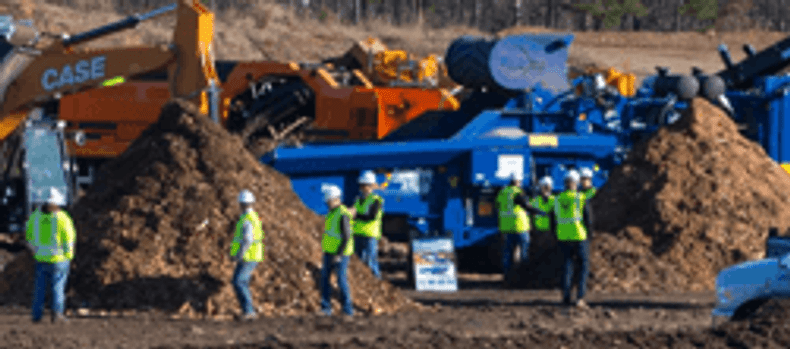- What wood and yard waste materials will be processed and what contaminants are expected?
- Where and how will the machine be operated and loaded?
- How will you handle repairs and maintenance on your machine?
Since previous or existing grinder owners most likely already have answers to all of these questions, this post will focus primarily on first time grinder buyers.
What Wood and Yard Waste Materials will be Processed and What Contaminants are Expected?
For tub grinders, length of material is of course relative to the machine in question; 10’ long is okay if the machine is 12’ wide at the infeed opening, 8’ long is okay if the machine is 10’ wide, etc. If you use a tub grinder with an infeed opening smaller than your materials length the material will constantly bridge across the infeed opening and production rate will be less than anticipated. Tub Grinders are typically better suited to handle heavily contaminated material. The tub infeed system of tub grinders helps to reduce damage to the hammermill as material has room to escape the hammermill before extensive damage. Also, most tub grinders have a feature which tilts the tub and provides direct access to the hammermill. This makes changing hammers and tips as well as other repairs to the hammermill significantly easier and more efficient than most horizontal grinders.
Longer length material is less of a problem for horizontal grinders, although organizing tree limbs to fit in a horizontal machine can be time consuming. Some customers control the length of material coming into their facilities by requiring that it be cut to shorter lengths. They are then able to save money by utilizing a smaller machine (by smaller I don’t necessarily mean lighter duty, just a smaller infeed opening). Due to teh enclosed grinding chamber of horizontals, contaminants can be a problem.
Manufacturers of both tub grinders and horizontal grinders are implementing new features into their machines to help reduce damage caused by contaminants. Late model horizontal grinders often include sophisticated software to help identify and back-out contaminants before they can cause significant damage. Also, more modern tub grinders and horizontal grinders have break-away screens below the mill that allow the contaminants to fall down to the discharge conveyor for removal. Some systems simply use a shear-pin, while more sophisticated systems use hydraulic cylinders mounted to the screen holder so that the screens can quickly be returned to operating position after ejecting potentially harmful material.
Broccoli vs. Pencil Rule:
- Tub grinders typically perform better with larger diameter material such as stump and root balls and brushier material. The large tub infeed opening makes it more efficient to get larger and bulkier items down into the hammermill and are easier to load with large bucket loaders.
- Horizontal grinders generally process longer, pre-organized material typically found in land-clearing operations better. This is because of the long infeed opening which reduces the need to shorten material significantly before grinding.
Where will the machine be operated?
Due to the horizontal feed system of horizontal grinders, they have become popular as an option for operating in more populated areas. The grinding mechanism in horizontal grinders is not exposed in a way that will easily allow material to escape out of the machine. Tub grinders on the other-hand rely on gravity to feed the hammermill at the bottom of the tub. When the material in the tub gets low and the hammermill becomes exposed it can eject material out of the tub. This makes tub grinders less suitable alternatives for grinding in some areas. Tub covers and shield have been added to some tub grinders to help reduce the amount of thrown objects, but the best way is to keep the tub full during normal operation. Also ejected material tends to exit in the direction that the hammermill spins; so positioning the grinder can help direct any ejected material. Tub grinders have been successfully employed in wood and yard waste recycling operations for 30 years, so although the danger of throwing objects can be a factor in your decision making process it can be mitigated with good safety controls and should not be the primary factor when trying to maximize your profits.
How will you handle repairs and maintenance on your machine?
Although both tub and horizontal grinders are employing increasingly more sophisticated computer systems to increase production rates, these systems make it more difficult for operators to make repairs themselves. Because of the complexity of the infeed system on horizontal grinders, they are typically more difficult to repair than tub grinders. The basic design and functionality of tub grinders has not changed significantly in nearly 20 years. Consequently, many operators prefer tub grinders based on the simplicity of the design and the ease with which they can make repairs to the machine.
Synopsis
There are several factors which affect buyers’ decisions when considering whether a tub grinder or horizontal grinder is right for them. We have addressed several considerations, such as material, grinding location, and repairs/maintenance. These are only some of the primary factors buyers must consider. After thinking through some of these base issues, we would be happy to discuss your operation at length and help recommend the best machine for you.

